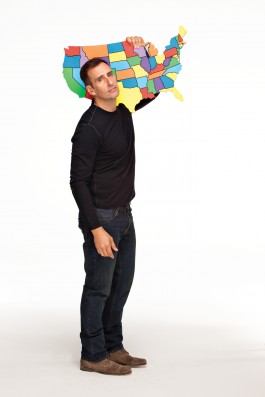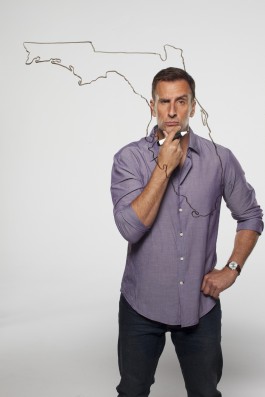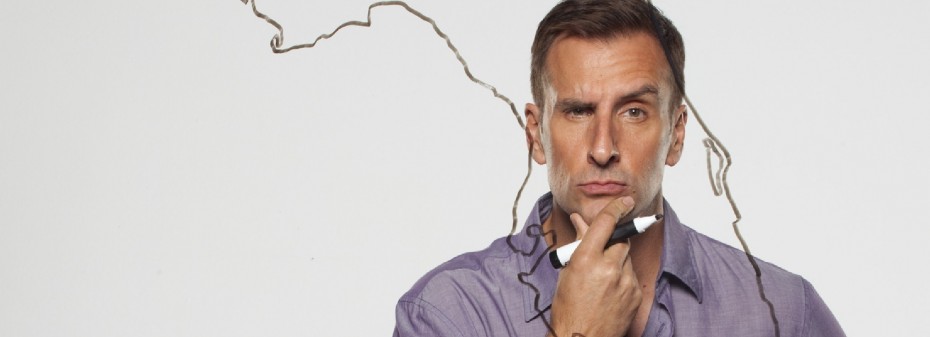INTERVIEW: Brian Unger puts the ‘united’ in United States for History series

How the States Got Their Shapes is back for some history lessons, and host Brian Unger probably couldn’t be happier. The second season of the series will air on History’s sister network H2, premiering Saturday, Sept. 29 at 10 p.m. What viewers will see on television will be the result of many hours of research, filming and brainstorming sessions. Although new features have been worked into the show, the premise is still the same: Unger and his team travel across the United States to test average Americans on how much they know their surroundings. The results are often hilarious and always informative.
Recently, Hollywood Soapbox spoke with Unger about what audience members can expect from the second season and the variety of lessons he’s learned on the road. Questions and answers have been slightly edited.
Are you getting a kick out of the show in the second season?
You know, I am. I worry that the viewers, whether they’re going to like it or not, I guess. But that’s probably typical, right?
Sure, sure. You have a lot of information. It’s kind of a history lesson told in a unique way.
Yeah, you know, this year it’s especially different with the quiz format. But we found the thing that really engaged viewers in season one was the regional trivia and really getting more people in various parts of the country to participate in gameplay and drawing states. It was the feedback we got from viewers, and so we kind of dialed that up significantly. And I have to say I’m having a lot more fun this season, just because I get to talk to, gosh, I don’t know, five or six more times the sort of regular folk, as we call them.
Could you imagine two years later you’d still be with the show? It started off as a special, right?
As with all successes with television, I sort of think they are accidental. So to answer your question, no, I didn’t think I’d be still doing this. The special was a … two-hour one-off based on Mark Stein’s book. The special did very well for History. There was a lot of positive feedback. … We’ve got such a broad reception, too. You know, John, we’ve had veteran History viewers love the show. We’ve had kids love the show. We’ve had teachers love the show. We’ve had highly cynical, jaded hipsters like the show. So it runs the gamut. It felt like a no-brainer to do it again. The only hat trick was to figure out a format this year, and then how to improve on the other things that we felt really excelled in season one.

It’s great to have some real history on History Channel. Sometimes you put on the channel, it might be focused on this or that. It’s kind of difficult to see the history aspect. But this you can feel good that there are some really good lessons that are conveyed.
The series moves to H2 this year, and it will only be seen on H2. As the bumper sticker says for the network: It’s more to history. And I think the “more to history” means probably less oriented toward some of the narrative docu-soap, nonfictional programs that you’re seeing on History. And probably dives a little deeper into more information. … Information first, and it happens to be fun to watch. At least it was fun to do. I’ll let viewers decide.
Are you a big history buff?
I’ve always had an innate inclination (for) … political science and politics. Our country is young enough so that it doesn’t seem impossible or insurmountable to get an understanding of our country’s history. And some parts of the country are incredibly new, like the western (parts) of the country. … It informs us about our political situation today. Whatever your political persuasion is — left, right or center — it informs who we are in our society and in our culture. So that’s a long way of saying, yes, I’ve always loved the history of the country and I was always interested in it as a student. You can ask Bob Hill … my old social studies teacher, what kind of a student I was. But I think he would probably say I was very average.
Does the show take a lot of your time? Can you flex your arms with some acting or comedy on the side?
I’ve learned to never complain about being busy, because when you’re not busy, it usually means you’re unemployed. So, I will say, that the show consumes a lot of time. And even when we’re not on the show shooting, you’re frantically trying to do all the other things. … I’m working for NFL.com right now. I just finished an episode of It’s Always Sunny in Philadelphia. And somehow ‘Team Unger,’ as I call them, manages to shoehorn all of these other things into my schedule. But H2 comes first. The show requires a lot of research, a lot of reading. It’s a little bit like going back to school. But luckily I have some really good people to kind of (take) me over the finish line.
How long on average does it take to film one episode?
We will shoot one episode generally over three days, and that is only with the shooting. And then there are many more days of conceiving of graphics. There are more days of writing. And then, of course, before we shoot, there are many more days of actually researching and preparing … and getting the lay of the land, quite literally, and sending scouts out to figure out where we’re going to shoot and how we’re going to tell the stories.
Have you been surprised by some of the stories on the road?
In season one, I said it’s a miracle we stay together as a union. We take so much for granted this idea of United States. I think in season two we decided to dig deeper into this idea. And we’re finding that it’s only amplified in season two, that we’re diving into some of the rivalries and some of the geographical conflicts that are embedded and most often hidden in the map. …
I think you see these differences manifest in these political races, as we come into this election year. People wonder why one state leans one way and why another leans the other, or why one state is particularly close, as we call bellwether states. … Swing states are fascinating. We look at Missouri, for instance, and we really traveled the state. And we looked at it closely. We came away essentially convinced that this is a state with an identity crisis. It doesn’t know whether it’s Midwest or South or North. In fact, that’s the way Missouri has always been.
Would you sign up for another season?
We’re doing 20 episodes this year, and you really only hit your stride until you’re three-quarters of the way done. And then you realize, wow, OK, so this is the show. This is the beating heart of the show. This is what really makes this thing work for us. So I would be really disappointed if we didn’t get to do another season, because I feel like we just sort of caught the tiger by its tail. Now I’d like to sort of ride it for another season.
By John Soltes / Publisher / John@HollywoodSoapbox.com
-
How the States Got Their Shapes returns to H2 on Saturday, Sept. 29 at 10 p.m. Click here for more information.


Brian Unger Rocks! He brings his viewers history with humor. But then again, his family loves him.
Brian Unger was anything but average. Smart, witty, engaged and full life. His contribution to the classroom was a joy.
I should add, that now he is teaching me !!!
I really enjoy the show, How the States got their Shapes, however, I noticed that when you aired the episode on West Virginia, you missed a little known fact about how the southern border between West Virginia and Virginia came to be. My husband’s last name is McClaugherty and his great-great grandfather is directly responsible for the shape of southern West Virginia. The McClaugherty family played a big part in settling the area of Giles County, Virginia. The McClaugherty plantation was located near Glen Lyn, Virginia. I will now quote from some information I found on the family. “It is said that at the close of the War Between the States, the land, several thousand acres, originally owned by James McClaugherty, Jr. and was then owned by his grandson, John Madison McClaugherty, was surveyed and was supposed to be included in West Virginia. McClaugherty got on his horse and rode to Richmond, Virginia and told them, ‘No-by G–! You are not cutting me off of Virginia. I fought for the South and I’m going to stay in it.’ It is stated that this is the reason that the line was run in such a peculiar shape. A close inspection of the map of Virginia, around the area of Glen Lyn, will show a definite area of land protruding into West Virginia. This is the land of James McClaugherty.
Love, Love, your show. My husband and I wouldn’t miss an episode for the world. Better than Downton Abbey, hahaha. Hope you continue to do specials for H2….you are marvelous and we love your sense of humor!!
My question, is: why do you shake people’s hands with your left hand? Did you hurt your right arm or something?
Thank YOU,
Is Brian left-handed? Everybody seems to write with their left hand on the show also. I know that more people are right-handed so it kind of doesn’t make sense. My only conclusion is Brian seems to write with his left hand but, if the camera is flipped 180° horizontally, and if he is right-handed, then it would make sense.